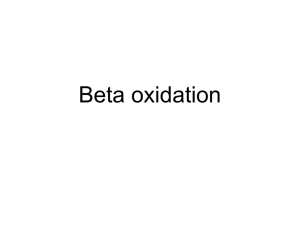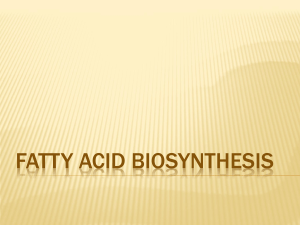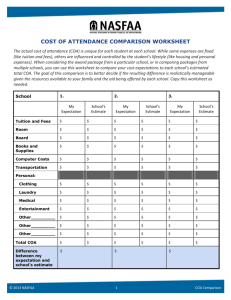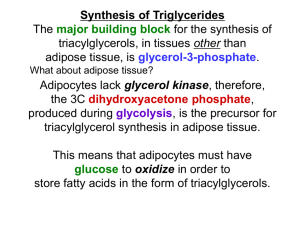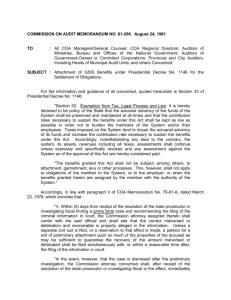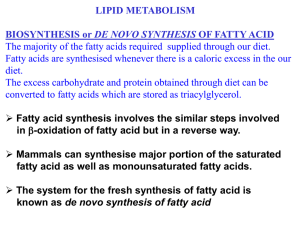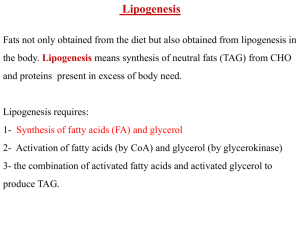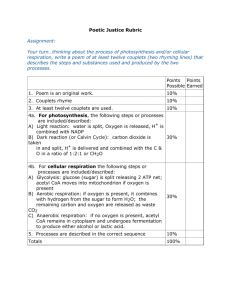ppt
advertisement
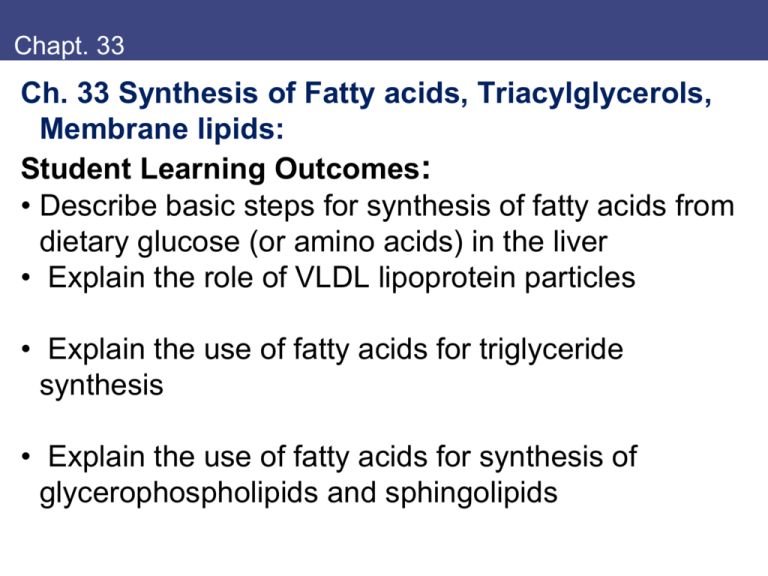
Chapt. 33 Ch. 33 Synthesis of Fatty acids, Triacylglycerols, Membrane lipids: Student Learning Outcomes: • Describe basic steps for synthesis of fatty acids from dietary glucose (or amino acids) in the liver • Explain the role of VLDL lipoprotein particles • Explain the use of fatty acids for triglyceride synthesis • Explain the use of fatty acids for synthesis of glycerophospholipids and sphingolipids Overview lipogenesis Overview of lipogenesis: synthesis of triacylglycerols from glucose: • • • • • • If excess calories; citrate moved from mitochondrion Acetyl CoA, Malonyl CoA, NADPH for fatty acids Mostly occurs in liver In cytosol TG packaged as VLDL Regulated pathway • Compare b-oxidation Fig. 1 OAA, oxaloacetate TG, triacylglycerol Overview Fate of VLDL-TG Overview: fate of VLDL-Triacylglycerols • TG is digested by LPL (lipoprotein lipase) on surface of capillaries (see Ch. 32) • FA for energy generation (muscle) • FA for storage (reform TG in adipose) • Glycerol returns to liver • See also Ch. 2 Fig. 2 Overview – membrane lipids Overview – membrane lipids A. Glycerophospholipids – diverse head groups B. Plasmalogen – platelet activation factor (ether link) C. Sphingolipid – serine not glycerol backbone D. Glycolipid – no PO4 See also Figs. 5.19, 20 Fig. 3 Fatty acid synthesis I. Fatty acid synthesis from excess carbohydrates A. Glucose to cytosolic Acetyl CoA • Two paths from pyruvate (gluconeogenesis, TCA) • Reciprocal inhibition/stimulation depends on [Acetyl CoA] • OAA + Acetyl CoA → citrate (1st step TCA) • Citrate transported to cytosol • Cleave to OAA + Acetyl CoA [PDH is only in mitochondrion; Fig. 4 Acetyl CoA can’t cross membrane] B. Citrate in cytosol B. Citrate in cytosol to Acetyl CoA: • Citrate lyase cleaves → Acetyl CoA and OAA • NADPH is required for fatty acid synthesis: • Some is made from Pentose Phosphate pathway • Other from recycling OAA back to pyruvate: • Reduce (uses NADH); recall TCA reversible reaction • Oxidative decarboxylate (makes NADPH) Figs. 5,6 ↑, inducible enzymes Fatty acid synthesis needs Acetyl CoA, NADPH Fatty acid synthesis needs Acetyl CoA, NADPH in the cytoplasm • NADPH from Pentose phosphate pathway • NADPH from Malic enzyme • Acetyl CoA from citrate lyase Fig. 7 B. Acetyl CoA to Malonyl CoA B. Conversion of Acetyl CoA to Malonyl CoA • One Acetyl CoA and many Malonyl CoA are needed • Malonyl CoA is immediate donor of the 2-C units • Acetyl CoA carboxylase requires biotin and ATP • • Acetyl CoA carboxylase is rate-limiting, highly regulated AMP levels signal fasting ([AMP]/[ATP] sensitive Figs. 8,9 C. Fatty acid synthase complex C. Fatty acid synthase complex: • Sequentially adds 2-C units from 3-C malonyl CoA • 2 reduction reactions after each addition (NADPH) • 16-C Palmitate is typical product • FAS is large enzyme: 2 subunits (one polypeptide each) with 7 catalytic activities and ACP domain • ACP – acyl carrier protein segment (Ser) is joined to a derivative of coenzyme A: • Oriented with phosphopantetheinyl SH group (PSH) of one subunit near Cys SH group on other Fig. 10 Fatty Acid synthase – 1st steps Fatty acid synthase – beginning 1. Acetyl CoA onto ACP P-SH group 2. Acetyl CoA transfers to Cys –SH of other 3. This Acetyl CoA will become the w (last) C of the fatty acid (i.e. carbon 16 of palmitate) 4. Malonyl CoA attaches to ACP SH 5. Malonyl CoA releases CO2; 2-C unit condenses with the Acetyl CoA, and a 4-C product is produced on ACP (C 13-16) Fig. 11* Fatty Acid synthesis Reduction reactions Fatty Acid synthesis: • Reduction reactions convert bketoacyl group • NADPH is reducing agent C=O → HCOH • HCOH → C=C • C=C → CH2-CH2 The 4-C unit will transfer to the SH of the Cys on other subunit Sort of opposite to b-oxidation Costs 1 ATP to form Malonyl CoA Costs 2 NADPH per addition Fig. 12 • • • • • Fatty Acid synthesis to palmitate (C16) Fatty acid synthesis: cycles of 2-C addition • • • • From 1 2-C Acetyl CoA and rest 3-C malonyl CoA End C was first added (last unit is the COOH end) Forms on ACP, then moves to Cys SH of other subunit Cleavage at end • 2 NADPH/cycle • 1 ATP/cycle • 1 CO2 added/ released Fig. 13 New fatty acid is not reoxidized in liver New fatty acid is not reoxidized in liver: • Inhibition of carnitine acyl transferase CPT1 • Longer fatty acids are made in Smooth ER by similar reactions involving malonyl CoA (Fig. 15) • Other enzymes desaturate the FA-CoA to form the unsaturated derivatives • Use O2, NADH (Figs. 16, 17) Fig. 14 Triacylglycerol synthesis II. Synthesis of TG, VLDL • Liver: phosphatidic acid + FA-CoA → Triacylglycerol (TG), made in smooth ER • Adipose cells do not have glycerol kinase • VLDL packages TG, phospholipids, cholesterol and proteins (apoB-100) • Processed in Golgi, secreted • More dense than chylomicrons (less TG) Fig. 18, 19 Summary of VLDL from liver Summary VLDL from glucose in liver: • VLDL secreted into blood • VLDL will get apoCII and ApoE from HDL Figs. 20, 21 Fed Fate of VLDL triglycerols IV. Fate of VLDL triglycerols in Fed state: • LPL lipase cleaves to FA + glycerol (like chylomicron) • ApoCII activates LPL • [Muscle LPL low Km, grabs FA] • IDL & LDL products (Ch. 34) Fig. 22 Fasting releases FA from Adipose tissues V. Fasting releases FA from adipose tissue • Insulin low, glucagon high; cAMP → PKA…. • Active Hormone Sensitive Lipase-P is TG lipase • FA travel in blood bound to serum albumin • Muscle oxidizes FA for energy • Liver makes ketone bodies from Acetyl CoA • Liver uses glycerol for gluconeogenesis Fig. 23 VII. Metabolism of glycerophospholipids, sphingolipids VII. Glycerophospholipids, sphingolipids: • Components of cell membranes, blood lipoproteins, bile and lung surfactants (see also Ch. 5) • glycerol backbone, serine (sphingosine) Fig. 25 A. Synthesis of glycerophospholipids A. Glycerophospholipids Similar to TG: Glycerol-3-phosphate + 2 FA →phosphatidic acid Then two paths to addition of head group; both use CTP Fig. 26 Some glycerophospholipids Some glycerophospholipids • Phosphatidic acid has PO4 on 3rd C of glycerol • Slightly different paths for synthesis of two groups • Both use CTP Fig. 27,28 Phospholipases degrade glycerophospholipids B. Degradation of glycerophospholipids • Different phospholipases attack different bonds • Enzymes in cell membranes, lysosomes • PL C cleaves PIP2 → DAG + IP3 • PL D → phosphatidic acid + alcohol head group • PL A2 cleaves off FA at C2 (often arachidonic, signaling) • PLA2 also repairs damage by free radicals to C=C) Fig. 30 Sphingolipids Synthesis of sphingolipids: • Intercell communication • AB blood groups • Receptors for viruses Ceramide is central molecule • Serine basis • Fatty acid addition, release CO2 • Reduction • Other fatty acid to NH2 group • Oxidation Fig. 31 PLP = pyridoxal PO4 Synthesis of some sphingolipids Sphingolipids are based on ceramide: • Addition of head groups to –OH (from serine) • Addition of sugars uses UDP-sugar • Degraded in lysosome • Deficiency diseases Fig. 32 other Adipocytes can also make hormones: • Leptin – identified as helping ob/ob obese mice lose weight • Binds JAK receptor/ signals through sTAT • Adiponectin – maybe linked to insulin resistance • AMP kinase, PPARg, enhanced fatty oxidaiton Metabolic syndrome associated with obesity: • Insulin resistance, obesity, altered blood lipid levels • High risk for type 2 diabetes, cardiovascular disease • Read description in text (Fig. 35) Key concepts Key concepts: • Fatty acids synthesized mainly in liver, from glucose • • • • Glucose to pyruvate in mitochondrion, forms Ac CoA, OAA, which form citrate Citrate in cytosol then to Ac CoA, malonyl CoA Fatty acid synthesis involve series 2-C additions from malonyl CoA to the w-C of Ac CoA onto FA synthase. Costs 2 NADPH and 1 ATP per cycle addition • Fatty acids packaged as TG in liver as VLDL with proteins and other lipids; digested by LPL on capillaries and FA enter cells (oxidized or stored) • Glycerophospholipids similar synthesis • Spingolipids from sphingosine (serine + FA) Review question Review question: 3. A patient with hyperlipoproteinemia would be most likely to benefit from a low-carbohydrate diet if the lipoproteins that are elevated in blood are which of the following? A. Chylomicrons B. VLDL C. HDL D. LDL E. IDL

